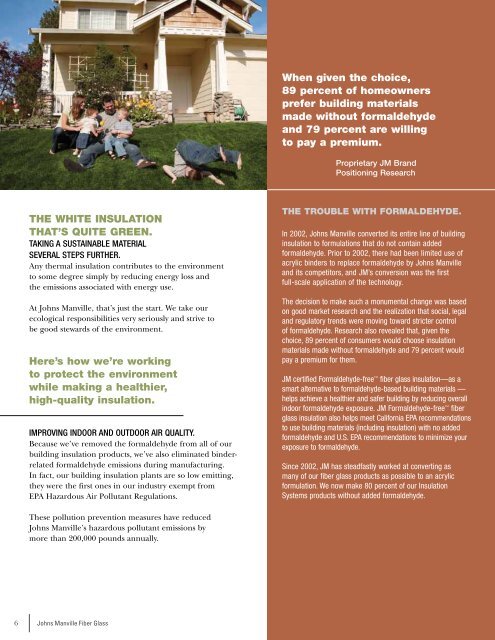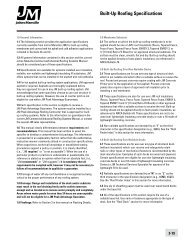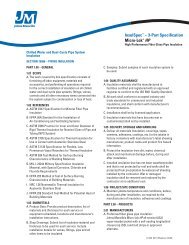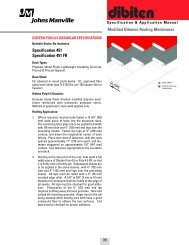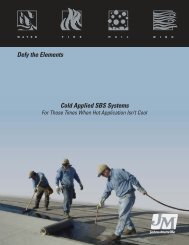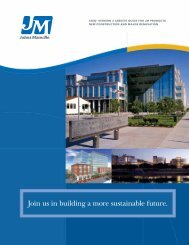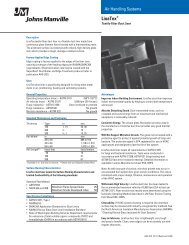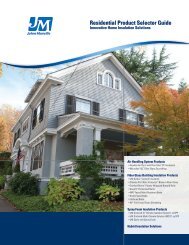JM Sustainability Brochure - Johns Manville
JM Sustainability Brochure - Johns Manville
JM Sustainability Brochure - Johns Manville
Create successful ePaper yourself
Turn your PDF publications into a flip-book with our unique Google optimized e-Paper software.
the white insulation<br />
that’s quite gReen.<br />
Taking a SuSTainable MaTerial<br />
Several STepS FurTher.<br />
Any thermal insulation contributes to the environment<br />
to some degree simply by reducing energy loss and<br />
the emissions associated with energy use.<br />
At <strong>Johns</strong> <strong>Manville</strong>, that’s just the start. We take our<br />
ecological responsibilities very seriously and strive to<br />
be good stewards of the environment.<br />
here’s how we’re working<br />
to protect the environment<br />
while making a healthier,<br />
high-quality insulation.<br />
iMproving indoor and ouTdoor air QualiTy.<br />
Because we’ve removed the formaldehyde from all of our<br />
building insulation products, we’ve also eliminated binderrelated<br />
formaldehyde emissions during manufacturing.<br />
In fact, our building insulation plants are so low emitting,<br />
they were the first ones in our industry exempt from<br />
EPA Hazardous Air Pollutant Regulations.<br />
These pollution prevention measures have reduced<br />
<strong>Johns</strong> <strong>Manville</strong>’s hazardous pollutant emissions by<br />
more than 200,000 pounds annually.<br />
6 <strong>Johns</strong> <strong>Manville</strong> Fiber Glass<br />
when given the choice,<br />
89 percent of homeowners<br />
prefer building materials<br />
made without formaldehyde<br />
and 79 percent are willing<br />
to pay a premium.<br />
Proprietary <strong>JM</strong> Brand<br />
Positioning Research<br />
the tRouble with FoRmaldehyde.<br />
In 2002, <strong>Johns</strong> <strong>Manville</strong> converted its entire line of building<br />
insulation to formulations that do not contain added<br />
formaldehyde. Prior to 2002, there had been limited use of<br />
acrylic binders to replace formaldehyde by <strong>Johns</strong> <strong>Manville</strong><br />
and its competitors, and <strong>JM</strong>’s conversion was the first<br />
full-scale application of the technology.<br />
The decision to make such a monumental change was based<br />
on good market research and the realization that social, legal<br />
and regulatory trends were moving toward stricter control<br />
of formaldehyde. Research also revealed that, given the<br />
choice, 89 percent of consumers would choose insulation<br />
materials made without formaldehyde and 79 percent would<br />
pay a premium for them.<br />
<strong>JM</strong> certified Formaldehyde-free fiber glass insulation—as a<br />
smart alternative to formaldehyde-based building materials —<br />
helps achieve a healthier and safer building by reducing overall<br />
indoor formaldehyde exposure. <strong>JM</strong> Formaldehyde-free fiber<br />
glass insulation also helps meet California EPA recommendations<br />
to use building materials (including insulation) with no added<br />
formaldehyde and U.S. EPA recommendations to minimize your<br />
exposure to formaldehyde.<br />
Since 2002, <strong>JM</strong> has steadfastly worked at converting as<br />
many of our fiber glass products as possible to an acrylic<br />
formulation. We now make 80 percent of our Insulation<br />
Systems products without added formaldehyde.


